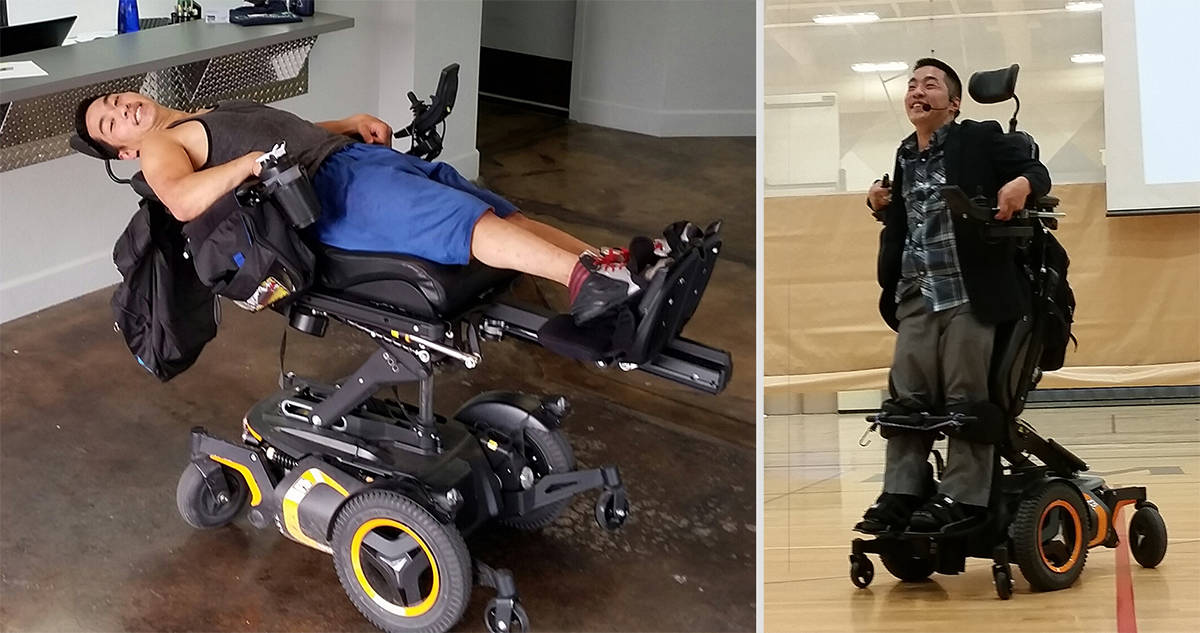Quadriplegia Explained
Quadriplegia, (tetraplegia), is a condition that impacts a person’s ability to move all four human limbs and torso due to a spinal cord injury. The condition is usually caused by severe damage to the cervical spinal cord, which can cause paralysis of the arms, legs, and body.
Depending on the severity of the injury, quadriplegia can also affect an individual’s ability to breathe, speak, and perform other activities.
What are Standing Wheelchairs?
Standing wheelchairs allow users to stand upright. This can benefit people with quadriplegia
who experience muscle atrophy and other health issues related to lack of movement. Standing wheelchairs are generally costlier than other mobility devices and might not be comfortable for everyone.
A standing feature is an available option on most high-level powered wheelchairs and you can find both mainstream as well as custom devices. Both the user and wheelchair companies benefit from constant advancements involving technology and mechanics to improve the quality of life. For the user, this not only raises the question of the reliability of the product but what the human body may or may not be capable of.
What are the Risks of Prolonged Sitting?
Several health problems are caused by prolonged sitting, such as pressure sores, poor blood circulation, internal cavities tightening up, etc. When the human body is seated, gravity hinders the body’s functions while when the human body is standing, gravity helps the body function better. Thus, people are generally told to not sit for a long time duration because it can cause health issues since it is essential for the human body to make movements.
Standing Wheelchairs Powered by a Battery
Standing Wheelchairs are either operated manually or powered by a battery. These are used to provide regular mobility and to help a person stand up without the need for someone else to lift them. Standing wheelchairs allow users to stand up with the use of either hydraulics or a battery.
The standing wheelchairs allow the user to drive the chair while in a standing position thereby allowing them to independently grab and reach for things that they are not capable of using without standing and walking. The driving while in a standing position feature is ideal for such a user who can do functional tasks while standing, for example, taking a walk around the garden, or cooking at home while standing.
Such a wheelchair is beneficial in more than one way; it is ideal for users with joint contracture since the vertical height at which one can comfortably stand- can be controlled by limiting the maximum height of the wheelchair. It can be used in this particular position until the muscles elongate sufficiently to allow an increased range of motion.
Advantages of a Standing Position
Life Quality Improvement
After a spinal cord injury, standing improves the quality of life by reducing the risk of secondary complications.
Circulation is Improved
When one cannot move their legs, there arises the problem of bad circulation, which can result in blood clots. Standing helps with the circulation of blood and keeps the blood pressure steady since the heart is pumping better.
Improvement in Respiration
When seated, the diaphragm has limited space, thus standing gives it more space to enlarge and shrink, which allows one to breathe in and out more effectively. This helps to strengthen the lungs and keeps one from being sick.
Increase in Bone Density
In the initial years after an SCI, the bones degrade the most and get weaker, resulting in osteoporosis. This can cause fractures. Bearing weight (standing) can strengthen the leg bones.
Improves the Health of the Skin
Standing helps with respiration, letting more oxygenated blood reach areas prone to pressure when in the sitting position. Standing is the ultimate pressure relief because it promotes skin health and also helps prevent pressure sores.
Efficient Bowel Function
Being unable to control your bowel movement, especially in case of accidents, can be frustrating. Standing improves bowel function and also helps in digestion.
An Improved Bladder Management System
Urinary incontinence occurs when you can’t control your bladder voluntarily. Standing helps to improve bladder function and also helps in preventing leakage, UTIs, as well as the need for bladder medication.
Keeps Muscles Relaxed
Standing helps in stretching the hamstrings, tendons, muscles, and heel cords. It reduces contractures, and muscle spasms which can help minimize the need for muscle relaxers or medication.
Provides a Greater Sense of Wellbeing Overall
Standing uplifts the mood and gives you more stamina as well as energy. This helps you sleep well and adds to your ability to do things properly.
What to Consider While Choosing A Wheelchair for Someone with Quadriplegia?
When choosing a wheelchair for someone with quadriplegia, you need to make careful consideration since it is a critical decision. Here are a few tips that can help you in selecting the right wheelchair for your people:
- Consider the size and weight- The size as well as the weight of a wheelchair are important considerations. Make sure you don’t choose a chair that does not fit properly or is too heavy to move around. A wheelchair that’s too small or huge could cause discomfort or even injury.
- The seating options- You should choose a wheelchair that provides proper support and comfort for the user. Note, that seating options may include adjustable back, arm, and footrests.
- Durability- Electric wheelchairs are durable and easy to maintain. Look for an option made from high-quality materials that can withstand regular use. Select a wheelchair you can easily maintain and find replacement parts.
- Testing the wheelchair- Before purchasing a wheelchair, ensure it’s comfortable and easy to use. Make sure the wheelchair is a good fit for the user and meets their preferences.
- Cost- Wheelchairs can be costly, so it is important to evaluate the cost of the same. An affordable chair should also provide the best value for your money. Also, check if your insurance includes the coverage of the wheelchair.






